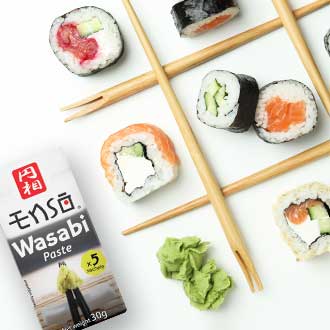What is wasabi? Everything you should know
Wasabi is famously known as a green spicy paste served as a condiment to all forms of sushi dishes. But it can be used to spice up many Japanese recipes, sauces, dressing, desserts and snacks.

What is wasabi and what is it made of?

The real wasabi is made from the rhizome of the Wasabia japonica plant, a plant of the family Brassicaceae.
Other familiar ingredients in this plant family includes horseradish, radishes and mustard, which contain a similar hot flavor to wasabi. And wasabi also has another name called Japanese horseradish. Real fresh-grated wasabi tastes bright and green with a touch of quickly fading heat. It tastes similar to hot mustard or horseradish rather than chili peppers in that it stimulates the nose more than the tongue. The Japanese have known and used wasabi for at least a thousand years. Before the 20th century, the rhizome was used as a medicinal plant and as a preservative that kept fish from turning bad and growing bacteria. During the Edo period (early 19th Century), wasabi had begun to be used as a seasoning for sushi dishes.
During that time there were no refrigerators or refrigerated facilities, people back then used wasabi to reduce the fishy smell of food and prevent food poisoning. (via Kinjirushi Wasabi) In the early 20th century, some manufacturers began making powdered wasabi by drying and pulverizing it and not long after that they began making powdered wasabi by using horseradish to substitute wasabi.

Nowadays most wasabi found in restaurants worldwide and grocery stores are not 100% authentic wasabi. Wasabia japonica plant is incredibly hard to grow and very demanding.
Only a few regions in Japan have the ideal conditions to commercially cultivate wasabi which makes the plant extremely expensive. Most mainstream wasabi products we know now are made of powdered horseradish and artificial color. It may also contain mustard powder, and thickening agents like flour or cornstarch. A few brands also mix some real wasabi to add delicious and authentic flavors to the paste.
Wasabi and horseradish are in the same family, they contain similar taste and pack with nutrients and health benefits. For example, they are naturally antibacterial and antiparasitic, boost circulation, fight colds and allergies, help with digestion.
So horseradish is also a good alternative for wasabi, but cheaper. Now the real wasabi is usually served in high-end Japanese restaurants and to capture the most flavor possible, wasabi is always served freshly grated. The traditional method for grating is to run the root in circles over sharkskin which acts like sandpaper, shearing very fine pieces of wasabi from the root. Since it loses the flavor in 15 minutes, the paste is only prepared when the customer orders.
How to eat wasabi with sushi?

The purpose of wasabi as a condiment is to neutralize the natural fattiness of raw fish and complement the taste, not cover it. If you use too much wasabi it may overpower the fish taste.
Try to use a moderate amount for the best taste and experience. When eating sushi, many people like to mix wasabi with soy sauce. However, sushi chefs discourage the mixing because it changes the flavours for both the soy sauce and wasabi. If you dine out at the restaurants and order nigiri sushi, typically the sushi chefs already place the proper amount of wasabi for the fish in nigiri when serving the dish. You probably get too much wasabi from the mixture.
So it is a good idea to keep soy sauce and wasabi separate. If you eat sashimi, the traditional Japanese way to eat wasabi with sushi is by dipping the piece of fish into a small amount of soy sauce and using your chopsticks or fingers to place some wasabi on the center of the fish.

The same method applies to eating sushi maki. However, if you have a kaisendon (seafood rice bowls), it is recommended to mix wasabi paste and soy sauce and pour the mixture over top the raw seafood and rice.
However, make sure you use the moderate amount of sauce and wasabi so it will not overpower the food taste. Start from picking a pea-sized dollop of paste from the serving plate and drop it in the mixing dish. Add a few drops of soy sauce and stir to dissolve the wasabi until no clump is left.
Add a bit more of soy sauce and taste to balance the flavor before pouring the mixture on top of food.

How to use wasabi in cooking?
- Salad dressing. Mix wasabi with rice vinegar or apple cider vinegar to make a spicy vinaigrette for salad dishes. Or add wasabi paste with cream cheese and mayonnaise for a thick, tasty dip.
- Sandwiches. Spice up your sandwiches by substituting wasabi paste with mustard. You can mix it with mayonnaise, avocado and salmon or add it to a grilled cheese sandwich for extra heat.
- Soba noodle. Soba is a mild Japanese noodle dish with salty and umami taste. It is simply served with dipping sauce and can be eaten hot or cold. Wasabi is often served alongside the noodle for an extra kick.
- Soups and stews. Wasabi can also be added to soups and stews to enhance the flavors of the dishes.
- Dipping sauce. Wasabi can add a real punch or a subtle accent to dips and sauces.
- Marinade meat or tofu. A simple way to add some Asian twist to your tofu or chicken steak by mixing a small amount of wasabi paste to your mixture when marinading meat.
- Snacks. You can create a healthy snack from wasabi like wasabi peanuts - roasted peanuts covered with wasabi coating that can add a good kick to your snack or appetizer.
Feeling some inspiration and want to taste or cook a new wasabi recipe? With a little help, you can cook delicious authentic Japanese cuisine at home.
Check out our products page.

